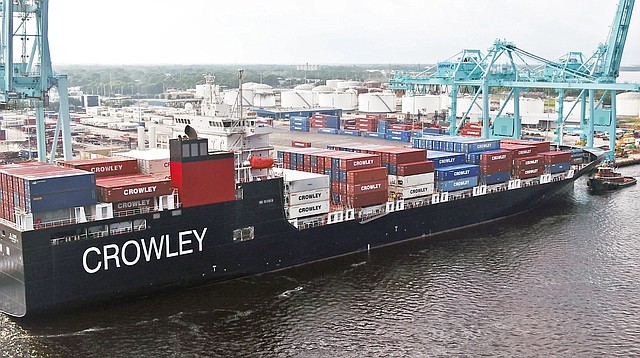Crowley Maritime Navigates Evolving Shipping Needs
Import/Export
With over 130 years of experience and 7,000 employees, Crowley Maritime is able to optimize a supply-chain solution for any manufacturer. | Photo courtesy of Crowley Maritime
As of Friday, May 20, 2022
The prettiest piece of fashion you’ve ever seen—and at the most unbelievable price—is of no use unless it’s in your size. Otherwise it’s no different than a shiny red sports car that doesn’t run. So, you can have the best relationships with the best manufacturers in Asia, who might even be the great unicorn of the business world and provide their services good, fast and cheap (normally you only get to pick two).
But the global pandemic of the past two years has changed the manufacturing landscape, and the ripple effects have become tidal waves across the ocean. “Nearshoring” may sound like an unnecessary new word, but the thing it describes is very real—the need to bring manufacturing back to the Western hemisphere, where the shores are nearer and transit times can be three days instead of 30.
Nearshoring is the biggest trend in shipping logistics, according to Jackie Gonsalez, vice president of supply chain for Crowley Maritime, which has 130 years of experience, 7,000 employees and $2.5 billion in annual revenues. “It doesn’t matter how great your relationship is with an Asian manufacturer, but if you have no way to get the product to where you need it, then what’s the point?”
Clothing, shoes and accessories have short life cycles driven by fast-changing styles tied to the weather, instant trends and other dynamic factors. In the wake of COVID and the growing options available through e-commerce, logistical practices such as shipping coordination have become more important than ever.
A piece of clothing may go around the world and back from its birth into the supply chain as a piece of fabric until it’s finally purchased and worn, and every glitch in the system prevents that final consummation from taking place.
Crowley knows the business of freight, or what’s known in the industry as logistics solutions. “We like to say that there’s no maritime company that can match our trucking services,” said Bob Goldenberg, Crowley’s vice president of commercial operations, “and no trucking company that can rival our ocean fleet.”
Clothing is transported across the globe through a combination of sea, road, rail and air methods, but the most common is the first as upward of 90 percent of apparel spends at least a portion of its journey through the supply chain on a ship. And, increasingly, it’s spending a lot more time on that ship plus more time sitting outside port waiting to dock and unload.
“For years labor in Asia was cheap and freight charges were relatively minimal,” said Goldenberg. “But the hottest topic we hear from the apparel industry now is that they’re all trying to figure out how to diversify their supply chain so they’re never caught like they were at the beginning of the pandemic. Moreover, they’ve seen their ocean freight fees go from $4,000 to $34,000. Then there’s the fact that their goods are 40 days away, take another 40 days to get stripped and another 10 to get out of terminal.”
Nearshoring means that instead of finding suppliers and manufacturers in places like China, India and Vietnam, you find them in Central America and the Dominican Republic. Each nation in this region tends to have its own specialty, such as Guatemala for denim.
One of Crowley’s logistics-solutions services, especially for apparel companies working exclusively with Asian manufacturers, is making introductions to partners in Central American countries.
“Nearshoring has become so important right now,” says Gonsalez, “that we’re actually seeing a lot of Asian vendors moving into those markets with pop-up manufacturing facilities all throughout Central America, bringing their experience closer precisely because of the supply chain. Asia just isn’t stable right now—just look at the shutdown in Shanghai.”
Rising apparel brands shouldn’t underestimate the importance of logistics and will find sustained growth a lot easier by partnering with a logistics-solutions provider.
“You can hand over your entire supply chain with a holistic view and have it optimized,” said Gonsalez, “including increased sustainability and decreased carbon footprint, reducing empty miles by loading the same box or truck for the next destination, and many advantages you get by working with a blended carrier that knows how to handle every piece of the process from the origins to delivery—customs, documentation, warehouse needs, ocean rail and trucking in both directions.”
Many apparel companies overemphasize their focus on marketing, but this only takes us back to the great dress in the wrong size and the pretty sports car that doesn’t run. Marketing is useless—will actually backfire—without the goods to back it up.
